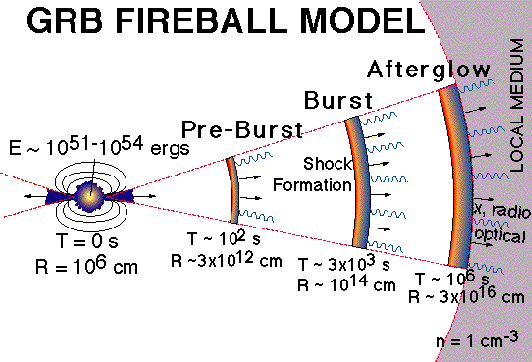 |
The extreme characteristics of GRBs seemed to lead to a paradox called
``the compactness problem'': assuming that the initial energy is released
in a volume
![]() (
(![]() is the variability timescale,
is the variability timescale,
![]() ms),
through photons with energies distributed according to a GRB spectrum,
then the optical depth for pair production is extremely high:
ms),
through photons with energies distributed according to a GRB spectrum,
then the optical depth for pair production is extremely high: ![]() .
On the other side, the obseved spectrum is definitely non-thermal;
the solution to this paradox is given by the relativistic motion for two
reasons: first, the compactness condition now becomes:
.
On the other side, the obseved spectrum is definitely non-thermal;
the solution to this paradox is given by the relativistic motion for two
reasons: first, the compactness condition now becomes:
![]() ,
where
,
where ![]() is the Lorentz factor; second, the rest frame energy of the
photons is smaller by a factor of
is the Lorentz factor; second, the rest frame energy of the
photons is smaller by a factor of ![]() : therefore, only a smaller fraction
of them can create pairs. Thus, the optical depth is reduced below 1,
provided that
: therefore, only a smaller fraction
of them can create pairs. Thus, the optical depth is reduced below 1,
provided that ![]() .
This requirement on the Lorentz factor
.
This requirement on the Lorentz factor ![]() limits the rest mass around
the burst source, thus requiring a small baryonic contamination
(
limits the rest mass around
the burst source, thus requiring a small baryonic contamination
(
![]() ).
).
Two scenarios have been proposed to convert the kinetic energy into photons: the so-called ``internal shock'' ([Narayan et al., 1992], [Rees & Mészáros, 1994]) and ``external shock'' ([Mészáros & Rees, 1993]). According to the latter, the relativistic matter runs into some external medium, either interstellar or wind earlier emitted by the progenitor, while in the former scenario the inner engine is assumed to emit many shells with different Lorentz factors and, for this, colliding into one another, therefore thermalizing a fraction of their kinetic energy.
 |
![[*]](crossref.png) ):
after the internal shocks produced the burst itself, the interactions
of the expanding shells with the surrounding matter are responsible for
the external shocks, which accelerate the electrons into a power law
distribution
):
after the internal shocks produced the burst itself, the interactions
of the expanding shells with the surrounding matter are responsible for
the external shocks, which accelerate the electrons into a power law
distribution
![[*]](crossref.png) shows the broad band sybchrotron
spectrum in the cases of fast and slow cooling, respectively ([Sari, Piran & Narayan, 1998]).
shows the broad band sybchrotron
spectrum in the cases of fast and slow cooling, respectively ([Sari, Piran & Narayan, 1998]).